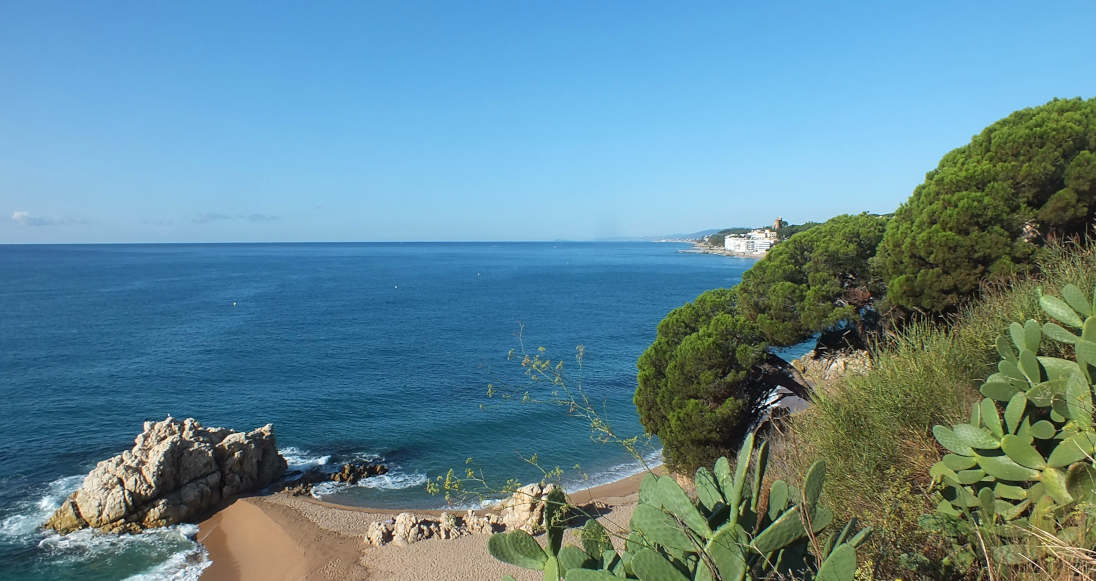
Catalonia - the Costas and inland
Barcelona, Girona, Lleida, Tarragona
About-Spain.net - the alternative guide to Spain
| On this page: | Barcelona | The coasts | Other sites |

Dawn over
Montserrat
The second largest region in Spain, with its second largest city Barcelona, and its own language, Catalonia sometimes feels like a separate country. Many would like it to be that way. But to visitors from abroad, Catalonia is part of Spain, and indeed for many is the defining part of Spain, since it receives more international visitors than any other region of mainland Spain.
For most visitors, Catalonia means the Costa Brava, the Costa Dorada or Barcelona. While Barcelona ranks as one of Europe's top tourist cities, and the Costas are among the most popular seaside areas, the rest of Catalonia, with its history, its monuments, its mountains and its interior in general remains largely ignored. Yet from the remarkable UNESCO World Heritage Sites of Tarragona and the Vall de Boi, to the Salvador Dali Museum in Girona, the awe-inspiring site of Montserrat, the peaks of the Catalan Pyrenees or the Spanish Railway Museum in Vilanova i la Geltru, Catalonia provides more than enough sites of interest to keep the most demanding of travellers busy for several weeks if not longer.
Place names in Catalonia
The first official language of Catalonia is Catalan; Castillian Spanish comes next. Place names tend to be written in Catalan on road signs, except on National routes like motorways where they are in both languages. Many maps show place names in Spanish. Catalan and Spanish being closely related (unlike Spanish and Basque), spelling differences are small. Most place-names ending in -as in Spanish end in -es in Catalan, so you may find references to Figueres or to Figueras. Other differences can be guessed - the beach in Catalan is Platja, in Spanish it's Playa.... and so on.Barcelona
► Click here for information on the Barcelona City Pass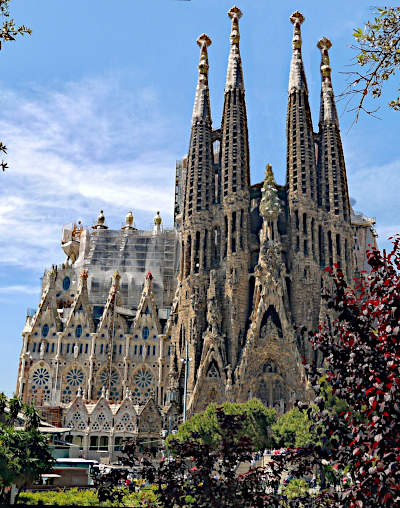 Sagrada Familia - Gaudi's masterpiece
Sagrada Familia - Gaudi's masterpiece In addition to the Sagrada Familia, Barcelona is home to a dozen or so more buildings and ensembles designed in the architect's quirky and unmistakable style. The best known of these is the Casa Mila, a.k.a. la Pedrera, which houses the Gaudi Centre, and is one of seven sites in and around Barcelona making up the UNESCO World Heritage site.
The throbbing heart of the city of Barcelona is Las Ramblas, Barcelona's Champs-Elysées. Stretching for over a kilometre between the port and the emblematic Plaça de Catalunya, Las Ramblas is a tree-lined boulevard that is at the heart of Barcelona life. A pedestrian area, it is lined with cafes, shops bars and restaurants, but like many urban touristy areas, it is reputedly a part of town where you need to be on your guard against tricksters and rip-oiff merchants.
In the old town, some 300 metres north of Las Ramblas, the Santa Eulalia cathedral is a fine Catalan gothic cathedral built mostly in the 14th century; beside it is a 15th century cloister.
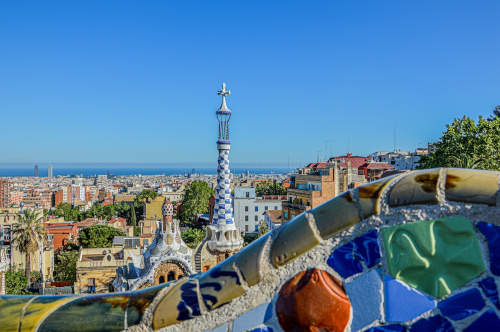
Barcelona skyline from Gaudi's Parc Guëll
The Catalan National Art Museum is located, like the Miro Foundation, half way up the hill of Monjuic, just south of the old port. The easiest way to reach the museums, and explore Montjuic with its spectacular views over the city and the coast, is to take the funicular, which connects with Metro lines 2 or 3 at the station called Paral-lel. From the top of the funicular, there are cablecars (telepheriques) around the hilltop, or city bus line 150 to the top of the hill. Another way to get up Montjuic is to take the (different) Aeri del Port cablecar from the old port. While the funicular can be used with a Barcelona public transport ticket, and is included in the Barcelona travel cards, cablecars are not.
Trips outside Barcelona
Visitors wanting to take a trip outside Barcelona are spoiled for choice, even if they do not have their own vehicle. There is an extensive rail network connecting the city with much of the area. Suburban line R1 from the main Sants train station or from Plaça de Catalunya station runs up the coast, literally beside the beaches as far as Mataro. Hop off at Montgat (which is in Zone 1, so included in City Pass or city travel card) or El Masnou for a day on the beach.The other great trip out of Barcelona is to visit the spectacular site of Montserrat (details below), which can be reached by train from Barcelona Plaça d'Espanya station, via the R5 line (Barcelona to Manresa). At the foot of the mountain, passengers must change either at Aeri de Montserrat station, for a cablecar to the monastery, or at Monistrol de Montserrat for the rack and pinion railway line up the mountain. Tickets for the whole journey, single or return, can be bought at the station, but take care; travellers must choose either the cable car route or the funicular when buying their tickets.
Take a visitor pass ?
The Barcelona City Pass, including public transport in central Barcelona (Zone 1), a harbour trip, a hop-on hop-off tour, a guided city tour, the Miro Foundation, the National Art Museum, the Museum of Contemporary Art, and a lot more is available for 109 € for two days, 119 € for 3 days, plus longer options.Note 1. Among the very few other Architects honoured in their own name by UNESCO are Le Corbusier, Vauban, Frank Lloyd Wright and Palladio.
The Catalan costas
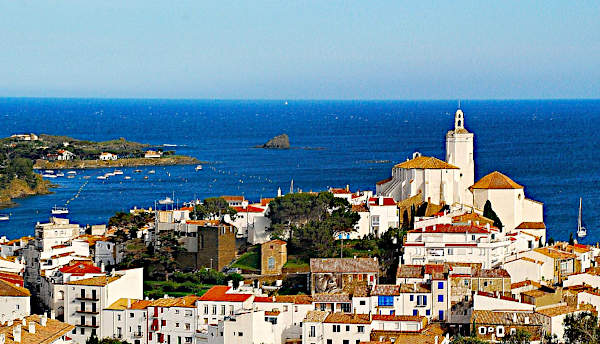
Cadaques, one of the small
towns along the Costa Brave.
The string of small picture-postcard fishing villages along the coast, with their whitewashed walls and Roman-tiled roofs, became the archetypal images of the Mediterranean. Naturally, in many cases, that quickly led to rapid and sometimes unregulated development, and the small villages developed into resorts – though mostly without the monstrosities that blighted many Spanish coastal areas further south. With only limited expanses of long sandy beaches, less flat development land close to the coast, and small towns and villages already occupying the space round the natural harbours, most of the coast, except very close to Barcelona, escaped the worst ravages of late twentieth century tourism development, and remains an attractive shoreline to this day.
While there is no shortage of holiday accommodation in the area, many small towns, like Cadaques, Roses, Llanca or Palafrugell have kept their character and remain attractive and – out of the main tourist season – quiet smalll towns or villages, where fishing boats are tied up alongside pleasurecraft.
The northern part of the Costa Brava is very rocky, with only small inlets. South of Roses, there are more loger sandy beaches. Yet beaches and harbours (plus bars and restaurants) are not the only attractions along the Costa Brava. For the more athletic, there is a 200 km coastal hiking trail running from Port Bou in France (accessible by train from Paris with 1 change, in just over 7 h, or from Perpignan direct in 50 minutes) to Blanès. Along the path, besides the parts of the Costa Brava that are inaccessible by any other means, there are many interesting sites, including the remains of the ancient Greek city of Empurias (Ampurias) near L'Escala. For a good guide to the coastal path, check out here.
The Costa Brava's most popular resorts are Blanes, Lloret de Mar,and Tossa, to the north of Barcelona, with Lloret reputed for its nightlife.
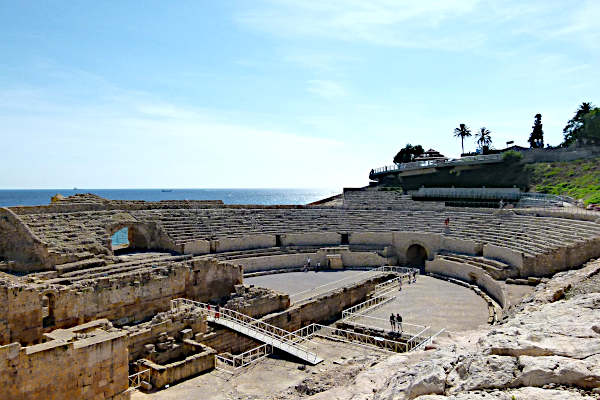
Tarragona's Roman amphitheatre, with the sea as a backdrop. .
Heading along the coast southwest from Barcelona, there's nevertheless a stunning 14 km section of coastal road, the narrow and twisting C31, between Port Ginesta and Sitges (best accessed by taking the C31 exit 42 before the start of the C32 Autovia at Port Ginesta).
The Costa Daurada (Costa Dorada) , between Vilanueva i la Gelitru (site of Spain's national railway museum) and L'Ametlla de Mar, is largely flat and developed with resorts such as Calafell and Coma Ruga, as well as theme parks and other distractions. In the middle of this area stands the historic city of Tarrgona, which has some of the best Roman remains in Spain. Seventy kilometres southwest of Tarragona, the southern Catalonia coast ends with a large expanse of protected wetland, the Ebro delta, which is one of Spain's great rice growning areas, an interesting area for wildlife, and part of the UNESCO Terres de l’Ebre Biosphere Reserve.
Elsewhere in Catalonia
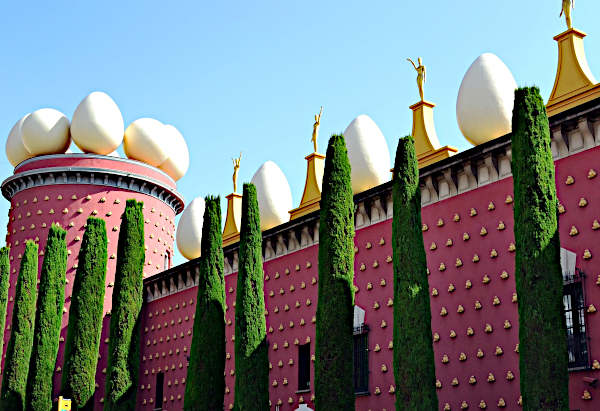
The Salvador Dali museum in Figueres. .
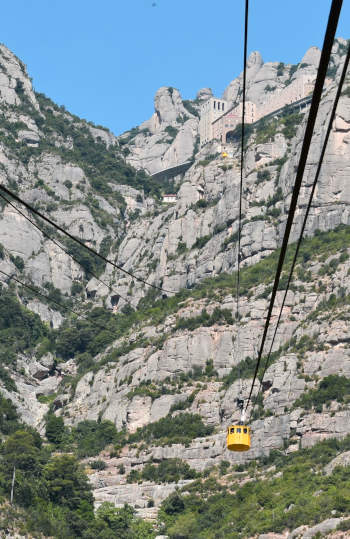 Cable car to
Montserrat
Cable car to
Montserrat Montserrat (photo above) is Catalonia's "holy mountain", and has long been home to an important monastery. Most of today's monastery buildings are under 200 years old, but monks have lived in this location since the ninth century. The monastery complex includes the basilica and, surprisingly perhaps, an impressive museum and art gallery with works by Dali, Miro and Picasso, as well as El Greco, Monet, Sisley and Degas. There are also two inns, and a campsite.
The views from Montserrat are spectacular, none more so than for those who spend the night up on the mountain, particularly at the campsite, and witness the sun coming up over the mists in the valleys below. It is an unforgettable experience.
From the monastery area, there are hiking trails to the top.
For rail access to Montserrat from Barcelona, see above.
Vall de Boi. Located in the northwest corner of Catalonia, in the province of Lleida, this high Pyrenean valley contains a remarkable collection of 11th - 12th century Romanesque churches, which are classed as a UNESCO world heritage site. While most of the original frescoes have been removed to the Museum of Catalonia in Barcelona (see above), faithful replicas have been recreated inside the churches such as Sant Climent in Taull. Anyone who visits the churches not knowing that the paintings are replicas will never guess; and seeing this fine Romanesque artwork in situ is somewhat more of a memorable experience than seeing it in a museum.
As for the Salvador Dali museum in Figueras, it is... well Dali. The master of Surrealism created the largest and most elequent expressions of surrealism in the shell of the former theatre in the heart of Figueres. Along with hundreds of works by Dali - paintings, prints, sculpture, jewelry - the museum has a small collection of works by other artists, including El Greco.
Ten more places to visit in Catalonia

The renovated city walls of Montblanc, between Barcelona and Lleida
As for other places to see in Catalonia, the best solution is to check out local tourist offices. For good measure, in alphabetical order, here are a few that are worth the visit.
- Aigues Tortes National Park - Catalonia's only National Park, in the high Pyrenees between the Vall de Boi and the French border.
- Congost de Collegats - A beautiful valley in the little-visited area of the Lleida Pyrenees. A great area for hikers and mountain-bikers. The dry river bed of the Barranco de l'Infern (Hell's Canyon) is also a top-notch attraction for canyoning - though not for the faint hearted. Location: on the N 260 east of Pobla de Segur, north of the little town of Tremp.
- Castell de Mur. This is an isolated medieval hilltop fortress with some fabulous views over the hills all around, .Location: off the C13 road south of Tremp.
- Besalu. This is a remarkably conserved "medieval" small town, which can be entered over a fortified Romanesque bridge. Location: West of Figueres on the N 261.
- Girona. Behind its fortifications of which some sections are still standing, the centre of Girona is a small historic city with a fine Catalan Gothic cathedral. The old city also contains one of the best preserved Jewish quarters in Spain and an impressive historical museum. Access: On the NI road and just off the A7 motorway between the French border and Barcelona.
- Montblanc. The historic centre of this small town is encircled by its 14th century ramparts and 25 defensive towers. A century ago few sections of wall were visible, as houses had been built up against them; but since the 1940s these have been slowly bought up and demolished, ruined sections of the walls have been rebuilt, to the point at which the town is now again encircled behind its ramparts. Location: 60 km west of Barcelona via the AP2 motorway.
- Poblet. The Monastery of Poblet is a UNESCO World Heritage Site, and one of the largest Cistercian abbeys in Europe. The monastery is built round a 13th century church, and includes a fortified royal residence and the pantheon of the kings and queens of Catalonia and Aragon.
- Ripoll. The recently renovated Santa Maria monastery at Ripoll is remarkable for its unusual two-storied romanesque cloisters. Just off the C17 30 km north of Vic
- Le Seo d'Urgell. A historic bishopric high in the Pyrenees. The St.Mary's Cathedral is a fine 12th century Romanesque building with an unusual colonaded apse and fine cloisters. Location : on the N145 / C 260 just south of Andorra.
- Vic. This small historic Catalan city has a fine central square, but also a very well preserved and renovated Roman temple. The episcopal museum has a large collection of medieval Catalan art, including frescoes saved from Pyrenean churches. Location: due north of Barcelona, by the C 17
Other
pages of interest :
- Andalucia - Extremadura - Valencia
- Undiscovered
Spain - The coasts
of Spain - Travel
in Spain
- Food
and eating in Spain - Driving in Spain
- Spanish
motorway map
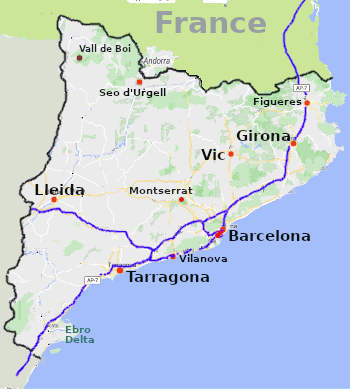
Catalonia, with main locations
Access
Getting to Catalonia:By car from the UK or Paris via the A71 / A75 / A9 route through France through Orleans and Perpignan
Fly to Catalonia: Barcelona airport BCN is well serviced with flights from all over Europe and beyond.
Low-cost carriers service airports at Girona and Reus.
By train: There are daily TGV high speed train services from Paris. and AVE high-speed services from Madrid. Through tickets bookable on the Trainline
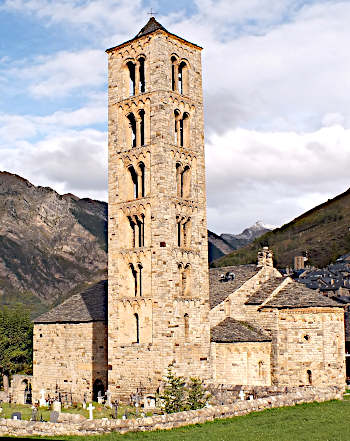
Late eleventh century church at Taull / Tahull, centrepiece of the UNESCO world heritage site of the Val de Boi
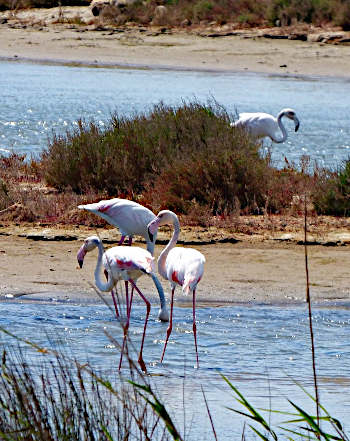
Flamingos in the Ebro Delta wetlands
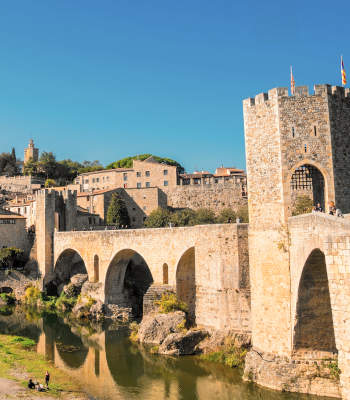
Fortified medieval bridge at Besalu
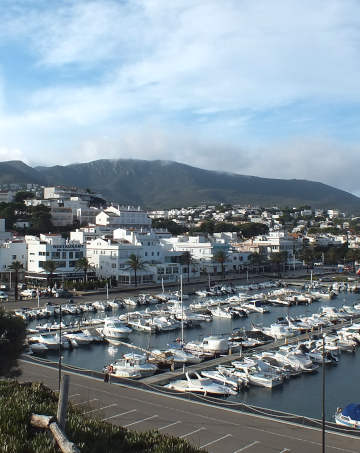
October morning in Llanca
Neighbouring
areas :
- Aragon - to the west
- Roussillon (France - French Catalonia) to the north
- Valencian region - to the south
| ►► Spain - a thematic guide: |
| Spain - the country Essential information about Spain. |
| Driving
in Spain Getting round Spain by car - roads and driving tips |
| Spain by train A guide to taking the train in Spain |
| Tourism
in Spain
Where to go and what to see |
| The coasts of spain |
| Top attractions in Spain |
| Andalucia |
| Eastern Andalucia |
| Western Andalucia |
| Asturias |
| Castile y Leon |
| Castile La Mancha |
| Extremadura |
| Valencia |
| Undiscovered Spain |
| Map of the Spanish regions |
| Accommodation
in Spain Where to stay, and the different options available |
| Spanish food and eating |
Text and photos copyright About-Spain.net
Except for photos:
Dawn over Montserrat - by Josep Monter
Sagrada Familia by Patrice Audet
Flamingos by Marc Pascual
Parc Guëll - by N Bader
Cable car to Montserrat - by Adam Hill
Photos of Besalu by Javier Rodriguez
and of Montblanc by Gitidfi
Licenced Creative Commons 2.0
